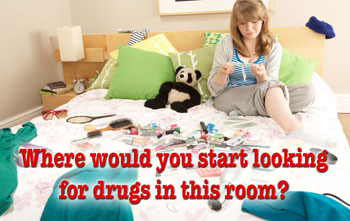If you’ve ever suspected one of your children of using drugs, you may have tried going through their pockets and their backpacks for pills, weed or other drugs. The sad truth is that any teen who wants to hide drugs has the ability to hide them so well that even a thorough search by a concerned parent won’t find them.
 How do they figure out where to put them? If they have the ability to access the internet for research or to buy a book, they have access to detailed instructions on how to hide drugs (or anything else) in places parents are unlikely to ever check.
How do they figure out where to put them? If they have the ability to access the internet for research or to buy a book, they have access to detailed instructions on how to hide drugs (or anything else) in places parents are unlikely to ever check.
A quick search of the resources available will give any parent a sinking feeling when they consider trying to confiscate drugs from a child who really wants to keep them hidden. Online forums dedicated to the use of drugs are a fertile place to start looking at the instructions available. Here’s just a few of the hiding places suggested by these sites:
1. Inside a dried-out marker or highlighter. Just cut out the foam and replace with drugs.
2. Behind a plate covering a light switch or electrical outlet.
3. Inside a disposable lighter. Just pull off the plastic cover on the bottom.
4. Above the ceiling, accessed through a bathroom vent.
5. Inside air conditioner ducts.
6. Buried in the back yard.
7. Inside old VHS or cassette cases.
8. Inside electronic devices like computer cases, speakers, game devices.
9. Inside a stick deodorant case, lip balm case or other similar item.
10. Hollow out an old iPod and fill it up.
Specially Purchased Items Enable Easy Concealment
There’s even specially made underwear with a zipper pocket for concealing anything from drugs to cash. One person advised others trying to smuggle drugs into drug-free music festivals that this underwear was his usual solution. Pre-hollowed lighters for drug storage (that will still light a cigarette or joint) can be purchased on Amazon.com, along with hollowed pens, hairbrushes, car cigarette lighters and even brand name water bottles that allow you to hide drugs under the section covered by the label. Just go to Amazon.com and type in “diversion.” You’ll find more than a thousand results for concealment. Some may be specifically designed to hide cash or firearms, but any of them can be used to conceal drugs, often in plain sight.
Something as innocent looking as a metal travel mug could provide a hollow container for concealing enough drugs to get through the day. If this mug is carried into work, no one will even give it a second glance. Fake sprinkler heads could be buried in the yard and never create suspicion, but allow someone to hide a small stash outside the home.
Perhaps the most distressing resource on hiding drugs is a series of videos on YouTube created by a former police officer. These videos provide instruction on how to hide your drugs in your car. This officer spent several years busting people for possession of drugs before deciding to make these videos. He even offers a video on hiding the heat emissions from illegal indoor marijuana grows so a building will never get raided.
So What Are Your Options?
You have a few choices. The first is to become just as adept as your child at hiding drugs. Especially if you have already found your child using or hiding drugs, you may not really have a choice. Do the same research your child may have done, make a list of possible hiding places and then look for the same items in your home, your child’s room or on her person. Try going to any search engine and typing in “where can I hide drugs from my parents.”
This Akron, Ohio newspaper reports on a display offered by a local children’s hospital that teaches professionals in the area to identify hiding places in a child’s room: http://inside.akronchildrens.org/2015/03/11/hidden-in-plain-sight-opioid-epidemic/. The educational display recreates a typical teenager’s bedroom and then invites parents and professionals to find the concealed items. This educational opportunity is often offered by anti-drug coalitions and law enforcement groups around the country. Watch your local newspaper for any such displays in your area.
If you have the means, you can consider hiring a company to screen your home with a drug-sniffing dog from time to time. You can learn more about this activity in this article from National Public Radio: http://www.npr.org/2014/07/15/331362828/drug-sniffing-dogs-ease-parents-minds-or-confirm-their-fears.
A better choice is to help your son or daughter leave drugs behind. This may have to be a gradual process but is the best possible solution. If your child is over 18 years old, Narconon can help. There are Narconon drug rehab centers in several parts of the US and others in Europe, Asia, Australia, Africa and South America. For those who are under 18, find a reputable teen program with recommendations from several parents who have sent a child there.
If you have a young teen, start now to teach them how dangerous drugs can be. Be truthful and don’t exaggerate the dangers. If you need some guidance on how to start this conversation, this guide can help and is free to read online: http://www.narconon.org/media/talking-to-kids.swf.
The Narconon Parent Center has many other resources to help you prevent drug abuse by your children. You can find those resources here: http://www.narconon.org/drug-abuse/parent-center.html.
We understand that keeping children drug-free until they are adults is more challenging today than it ever was in the past. We offer our these resources for your success.